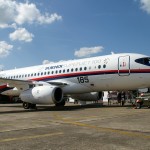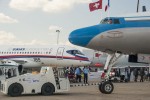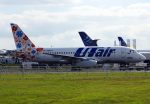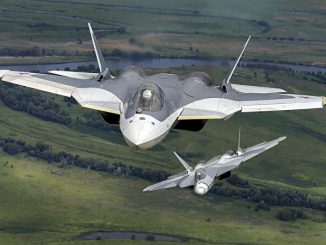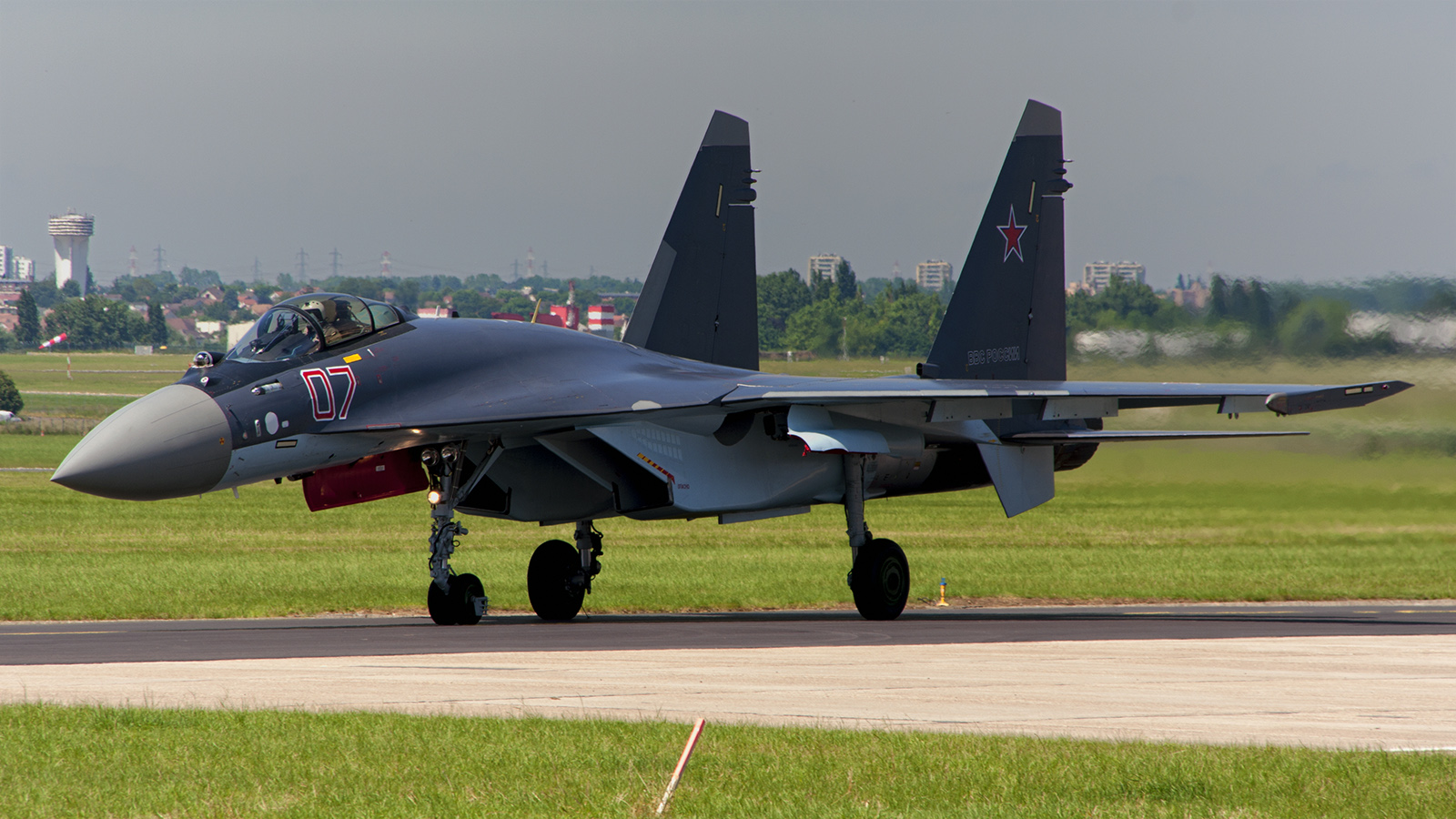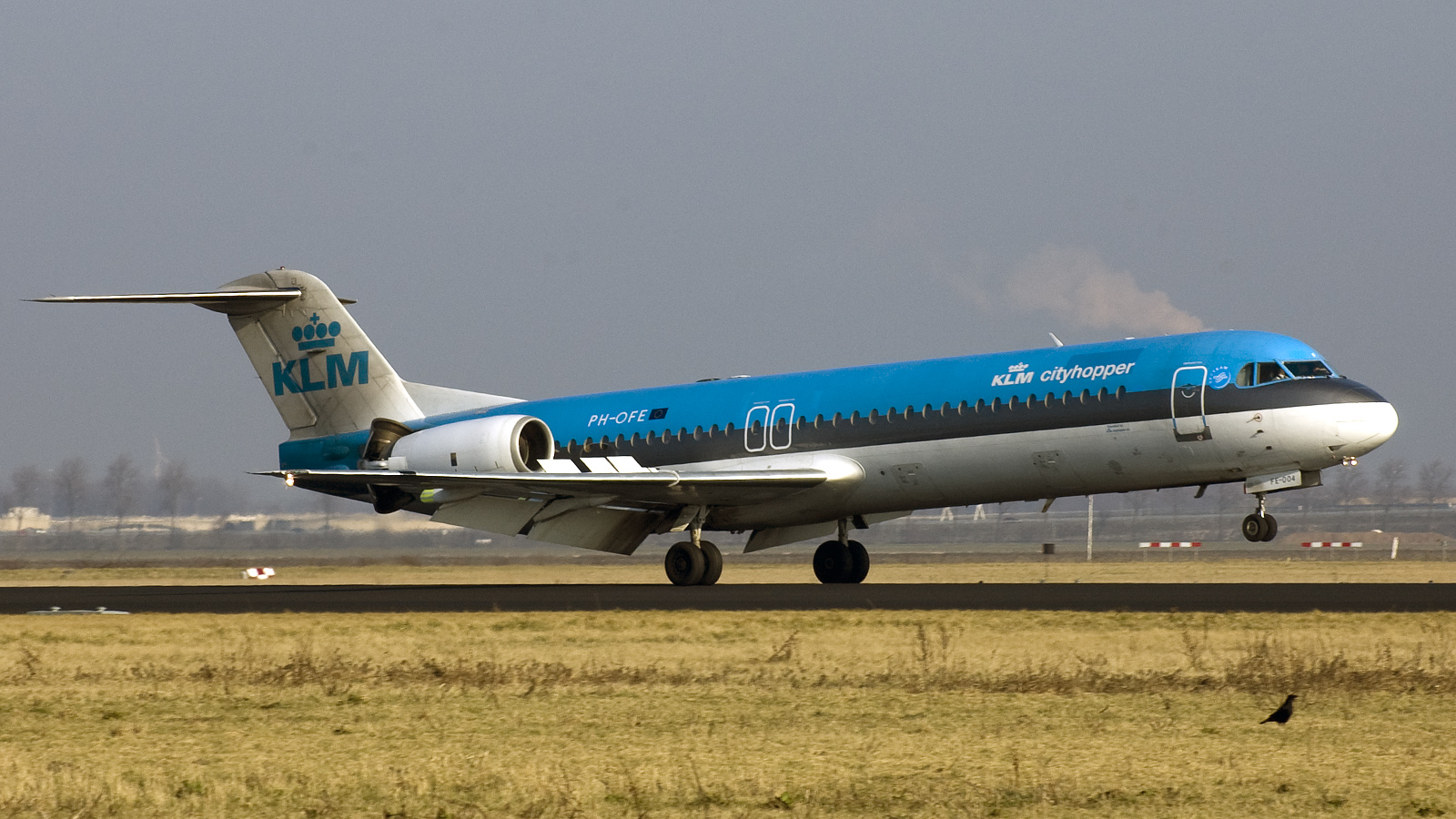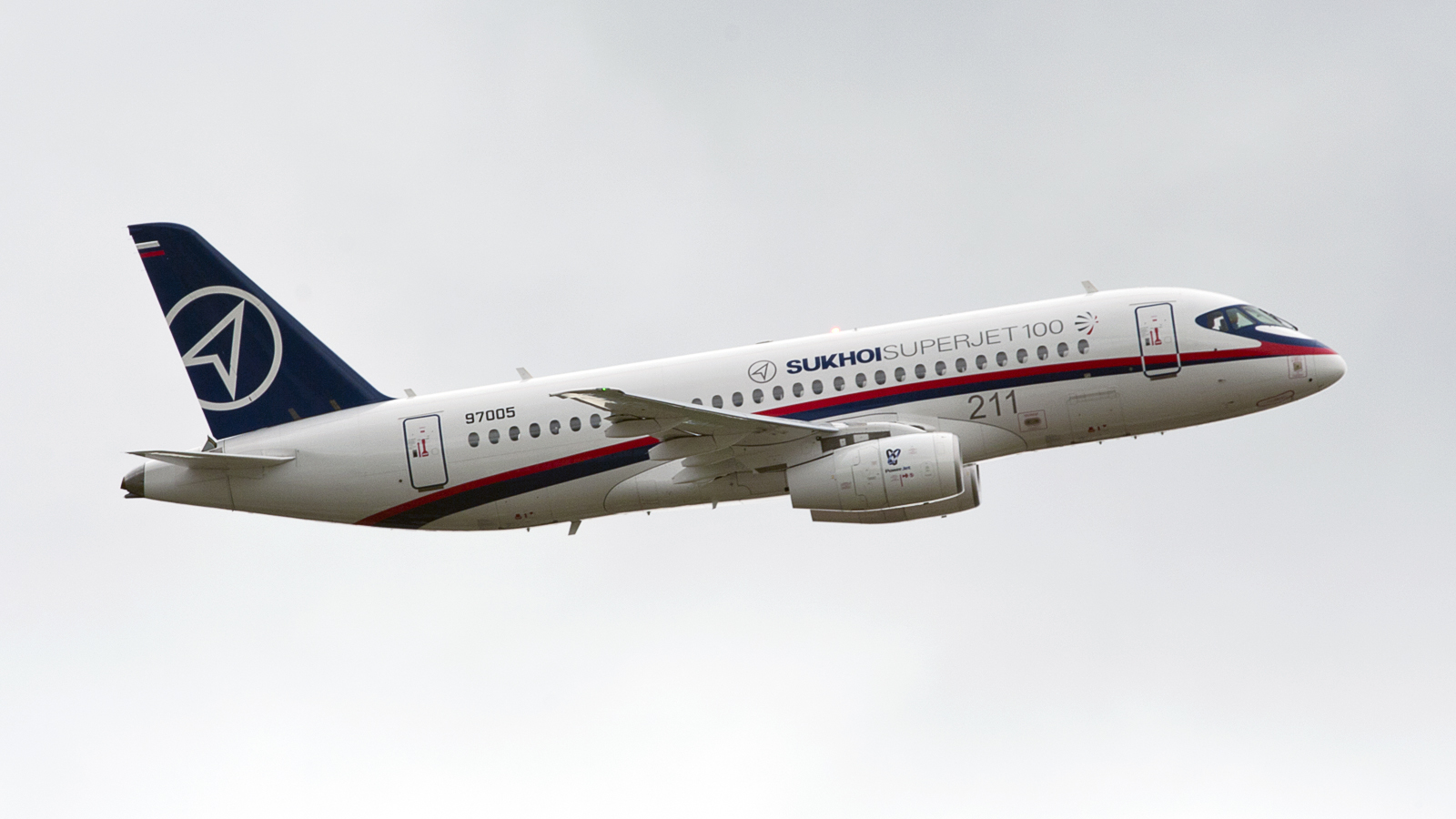
Sukhoi Superjet 100 (SSJ 100) is a modern Russian, fly-by-wire regional jet in the 75- to 95-seat category. The assembly line for all versions of the Sukhoi Superjet 100 is located at the Komsomolsk-on-Amur Aircraft Production Association (KnAAPO), based in Komsomolsk-on-Amur in the Russian Far East.
Developing nation: Russia.
Manufacturer/designer: Sukhoi Aircraft Company.
Production Lines: Komsomolsk-on-Amur Aircraft Production Association (KnAAPO), based in Komsomolsk-on-Amur.
Type aircraft: Airliner.
First flight: 19 May 2008.
First delivery: 21 April 2011 with Armavia.
Produced: 2007 – present
State: in service.
The leading-edge technologies, being the core ingredient of the Sukhoi Superjet 100 Project, penetrate its every stage – from design and development to final assembly, delivering a modern, economically efficient and globally marketable aircraft.
SSJ100 is easy and safe to pilot. The cockpit design features a “passive” side stick and “active” engine control levers. The Human Centered Design concept perfectly arranges the control levers and on-board equipment. SSJ100 can be landed by one pilot only. Dark and Quiet Cockpit offers precise, convenient and reliable piloting of Sukhoi Superjet 100.
Optimal piloting in automated mode together with the failure-safe flight control system ensure additional fuel efficiency and improve flight safety. The remote control system (RCS) is based upon three two-channel upper level computers (PFCU – Primary Flight Actuator Control Unit) adding two-channel lower level computers (ACE – Actuator Control Electronics). PFCU’s process command signals coming from the cockpit, autopilot and avionics. Besides, it optimizes piloting performance in all flight modes. The unsurpassed functionality of PFCU results from Sukhoi Design Bureau’s experience in development of FBW systems with automatic limitation of ultimate and operational flight parameters in manual and automatic control modes. Solid reliability of the aircraft systems and pilot induced failure proof functionality increase flight safety. Sukhoi Superjet 100 is sure to become the first regional aircraft, enjoying such advanced control system features. In case of in-flight system failures, the RCS switches to the standby control circuit offering piloting characteristics similar to those of manual flight mode.
Sukhoi Superjet 100 features fully electronic fly-by-wire control system for piloting, landing gear extension and retraction, and a break system to prove its high maintainability and weight perfection.
Sukhoi Superjet 100 failure-safe FBW architecture means no more mechanical redundancy. The horizontal stabilizer is also controlled by fly-by-wire, leading to stabilizer optimal size and reduction of aerodynamic and trim resistance. Sukhoi Superjet 100 is algorithmically protected against tail/runway collision induced by pilot.
The THALES designed avionics open architecture is based on the integrated modular technology. This helped to decrease the number of structure modules by 15% and to facilitate maintenance procedures.
Sukhoi Superjet 100 is equipped with the built-in failure detection system able to find any failure including those at the LRU level of any major aircraft system. Moreover, the basic configuration of avionics offers wider functionality, including triple ultra-short-wave communication system with ACARS function, the second generation T2CAS system designed to prevent collision as well as the IIIA ICAO category approach capabilities.
Each aircraft is powered by the new SaM146 engine developed by PowerJet to meet the highest performance and eco requirements. Snecma Moteurs and NPO Saturn?s distinct experience and perfect synergy produced a hi-tech result by applying the CFM56 & Tech56 technologies when creating an engine distinguished for its excellent performance.
A strong focus was put on engine maintainability. Now the blades can be replaced with engine on the wing. Owing to the new modular design, the engine employs 20% less parts, which significantly streamlines maintenance operations.
The double-bubble fuselage expanded “life space” for each passenger up to 0.885 m3 and increased the height of the cargo compartment up to 1014 mm.
It is obvious that leading-edge technologies applied in design & development demand state-of-the-art technologies in production.
The new technologies introduced at SCAC’s production sites are: automatic riveting and high-speed part machining, information environment, embracing design, production and supply into common environment, airframe jigless assembly with laser positioning, manufacturing of wing panel and wing coupling to the fuselage with no manual adjustment.
Super Economics:
The SSJ100 aerodynamic configuration is specifically optimized for high cruise M-speed. That is why speed increase does not lead to a dramatic increase in fuel consumption. When compared with its rivals bound to fly at M 0.75 – 0.76 to stay in economic mode, SSJ100 has higher cruise speed.
SSJ100’s enhanced take-off and landing performance along with all-weather operation, wide range and passenger payload capabilities make SSJ100 an efficient route developer. This offers airlines freedom in route and schedule planning.
Super economics results from crew training cost reduction when operating different types of the SSJ100 aircraft as a single fleet. Furthermore, this advantage stems from easy-to-reach maintenance zones, 20% reduction in the number of modular engine components (SaM146) and 10% cutback in fuel consumption.
Sukhoi Superjet 100 offers 10% decrease of operation costs due to its weight perfection, economic fuel consumption and lower maintenance costs.
Energy saving all-LED passenger cabin lightning helps airlines decrease maintenance costs on lighting.
The dimensions of the cargo compartment completely meet the challenging requirements of trade unions regarding the work of ground personnel.
While Sukhoi Superjet 100 belongs to the regional class, its long-range (LR) version can effectively operate on a number of mainline routes.
Super Fuel Efficiency:
Fuel efficiency is secured by the third generation supercritical airfoil wing and excellent local aerodynamics. All this combined with perfectly balanced aircraft control laws in autopilot mode add to fuel consumption savings. Weight perfection and the SaM146 engine, tailored for this aircraft family, reduce fuel consumption per seat by 10% compared to its rivals. Super Green:
Noise and emissions levels of SSJ100 meet the strictest ecological demands and surpass the highest existing and future ICAO requirements.
Specifications
| SSJ 100–75 | SSJ 100-75LR | SSJ 100–95 | SSJ 100-95LR | |
|---|---|---|---|---|
| Cockpit crew | 2 | |||
| Seating capacity | 83 (1-class, dense) 78 (1-class, standard) 68 (2-class, standard) | 103 (1-class, dense) 98 (1-class, standard) 86 (2-class, standard) | ||
| Seat pitch | 30 in (1-class, dense), 32 in (1-class, standard) 36 & 32 in (2-class, standard) | 31 in (1-class, dense), 32 in (1-class, standard) 36 & 32 in (2-class, standard) | ||
| Length | 26.44 m (86 ft 9 in) | 29.94 m (98 ft 3 in) | ||
| Wingspan | 27.80 m (91 ft 2 in) | |||
| Height | 10.28 m (33 ft 9 in) | |||
| Fuselage max diameter | 3.35 m (11 ft 0 in) | |||
| Cabin width | 3.236 m (127.4 in) | |||
| Cabin height | 2.12 m (6 ft 11 in) | |||
| Aisle width | 51 cm (20 in) | |||
| Seat width | 46.5 cm (18.3 in) | |||
| Volume bins per passenger | 0.07 m3 (2.5 cu ft) | |||
| Maximum take-off weight (MTOW) | 38,820 kg (85,600 lb) | 42,280 kg (93,200 lb) | 45,880 kg (101,100 lb) | 49,450 kg (109,000 lb) |
| Empty weight (OEW) | – | – | 25,100 kg (55,000 lb) | – |
| DOW | – | – | 26,600 kg (59,000 lb) | – |
| Maximum landing weight | 35,000 kg (77,000 lb) | 41,000 kg (90,000 lb) | ||
| Maximum payload | 9,130 kg (20,100 lb) | 12,245 kg (27,000 lb) | ||
| Maximum fuel capacity | 13,135 L (10,600 kg or 23,370 lb) | 13,135 L (10,600 kg or 23,370 lb) | ||
| Cargo capacity | 15.01 m3 (530 cu ft) | 21.97 m3 (776 cu ft) | ||
| Takeoff run at MTOW | 1,515 m (4,970 ft) | 1,731 m (5,679 ft) | 2,052 m (6,732 ft) | |
| Maximum flight altitude | 12,500 m (41,000 ft) | |||
| Cruising speed | Mach 0.78 (828 km/h/511 mph / 448knots at 11,000 m/36,000 ft) | |||
| Maximum cruise speed | Mach 0.81 (870 km/h/ 541 mph / 469knots at 11,000 m/36,000 ft) | |||
| Range (full passenger payload) | 2,900 km (1,800 mi) | 4,550 km (2,830 mi) | 3,048 km (1,894 mi) | 4,578 km (2,845 mi) |
| Engine (x 2) | PowerJet SaM146 | |||
| Takeoff thrust (x 2) | 13,500 lbf (60 kN) | 15,400 lbf (69 kN) | ||
| APR thrust (x 2) | 15,400 lbf (69 kN) | 17,500 lbf (78 kN) | ||
| Fan tip diameter | 1.22 m (48 in) | |||
| Engine length | 2.07 m (81 in) | |||
Sources: Sukhoi Civil Aircraft Company.
Russian Sukhoi plane missing on test flight in Indonesia 9 May 2012
A Russian Sukhoi passenger plane (97004) with 46 people on board, including businessmen and Russian envoys, has gone missing during a demonstration flight over West Java in Indonesia, officials said.
Indonesia’s search and rescue agency said radio contact was lost with the plane after it descended to 6,000 feet. The Indonesia military said the plane “fell” from the sky.
“The plane was doing the first flight around midday and returned to the airport, but when it took off the second time, it lost contact around Bogor,” said Bambang Ervan, the transport ministry spokesman.
All pictures courtesy of Zijde Aviation Photo and Publishing, Rob Vogelaar and Marcel van Leeuwen.




